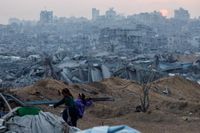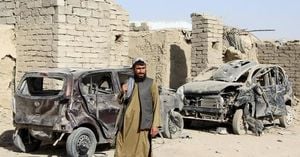In the war-ravaged Gaza Strip, the human cost of conflict continues to mount as new figures released by Gaza health officials on November 8, 2025, reveal that more than 69,000 Palestinians have now lost their lives since the outbreak of the Israel-Hamas war on October 7, 2023. According to Gaza’s Health Ministry, the death toll has reached a staggering 69,169, with another 170,685 people wounded. These numbers, reported by the Associated Press and other international outlets, underscore the immense toll the conflict has taken on the civilian population.
The recent spike in deaths is attributed not only to ongoing violence but also to the grim work of recovering bodies from the rubble of destroyed neighborhoods and the identification of previously unrecognized victims. As the dust settles under a fragile ceasefire, rescue workers and families are sifting through debris, hoping for closure—or, in many cases, fearing the worst.
This latest count comes amid a tense exchange between Israel and Hamas under the terms of a U.S.-brokered truce. On November 8, Israel returned the bodies of 15 Palestinians to Gaza, a gesture mirrored by militants who, a day earlier, handed over the remains of an Israeli hostage. That hostage, identified as Lior Rudaeff, was killed during the initial Hamas-led attack that ignited the war. Prime Minister Benjamin Netanyahu’s office confirmed Rudaeff’s identity, and the Hostages and Missing Families Forum noted that he was born in Argentina.
These exchanges are at the heart of the ceasefire’s first phase. For each Israeli hostage—or their remains—returned by Hamas, Israel has agreed to send back the remains of 15 Palestinians. The Nasser Hospital in Khan Younis received the latest group of bodies, bringing the total number of Palestinian remains returned to 300, according to Ahmed Dheir, director of forensic medicine at the hospital. Of these, only 89 have been identified thus far. "We do not have sufficient resources or the DNA to match them with the martyrs’ families," Dheir explained, highlighting the logistical and emotional challenges facing families desperate for answers. Unidentified bodies, he added, will be buried in batches, a somber reflection of the scale of loss.
For many families, the process is agonizing. Hopeful relatives crowd around body bags, searching for loved ones among decomposed remains. "Close it, it’s not him," one family said after checking a body. Another mother, still searching for her missing son, told reporters, "I always come here. I have not lost hope. I am still waiting for him." These scenes, reported by the Associated Press, are repeated across the territory as the search for closure continues.
The truce, though fragile, represents a rare pause in what has been described as the deadliest and most destructive war ever between Israel and the Palestinian militant group. The conflict erupted with the Hamas-led assault on southern Israel, which killed about 1,200 people and resulted in 251 hostages being taken, according to Israeli officials. Since then, the violence has left vast swathes of Gaza in ruins, with civilians bearing the brunt of the devastation.
Gaza’s Health Ministry, which operates under the Hamas-run government but is staffed by medical professionals, has maintained detailed casualty records. These records are generally considered reliable by independent experts and international organizations. The ministry noted that 284 people were added to the death toll between October 31 and November 7 after their identities were confirmed. In just the past three days, 10 bodies—nine retrieved from the rubble and one newly killed—were brought to Gaza hospitals. Since the ceasefire began on October 10, 2025, the ministry says, 241 people have been killed in Gaza, with many more missing and presumed dead.
While the ceasefire has brought a measure of relief, violence has not entirely ceased. Israel’s military reported on November 8 that its soldiers had killed two militants—one in northern Gaza and another in the south—who had approached troops. The ongoing danger is a stark reminder that peace remains elusive, even amid diplomatic efforts to wind down the conflict.
The violence has also spilled over into the occupied West Bank, where tensions are running high during this year’s olive harvest. On the same day as the body exchange, Israeli settlers reportedly staged two attacks on Palestinian farmers and others. According to Palestinian health officials, 11 people were injured in the town of Beita, including journalists, medics, international activists, and farmers. The United Nations humanitarian office reported that October 2025 saw more than 260 settler attacks on Palestinians and their property—the highest monthly total since the UN began keeping records in 2006.
Jonathan Pollak, a long-time activist, described the chaos to the Associated Press: "I was picking olives when dozens of masked Israeli settlers, armed with clubs, descended, chasing people and throwing rocks." Pollak himself was struck in the head and hospitalized. He recounted seeing five settlers attack a journalist and her security guard, beating her and denting her helmet. Reuters confirmed that two of its journalists were attacked despite identifying themselves as press, and called on Israeli authorities to investigate and hold those responsible accountable.
Israel’s military acknowledged dispersing a confrontation "between Israeli civilians and Palestinians during an uncoordinated olive harvest in an area that requires prior coordination" and noted that several Palestinians had been injured. Rights groups, however, contend that accountability for settler violence remains rare. According to a Haaretz report from 2022, Israeli police pressed charges in only 3.8% of such cases, with most investigations closed without action.
Elsewhere in the West Bank, Palestinian paramedics reported another settler attack in the village of Burin, where four international activists and a 57-year-old man were injured. The Palestinian Red Crescent said settlers had assaulted the group, while Israel’s military said that soldiers responded to rock-throwing at an Israeli vehicle and that Israeli civilians then hurled rocks at harvesters, resulting in injuries on both sides.
As the ceasefire holds—at least for now—families on both sides are left grappling with grief, uncertainty, and the hope for resolution. In Tel Aviv, families and supporters rallied once again, calling for the return of all hostages. In Gaza, the search for missing loved ones continues amid the ruins. The U.S.-brokered truce may have brought a temporary halt to the fighting, but the scars of war remain fresh, and the path to lasting peace looks as uncertain as ever.






